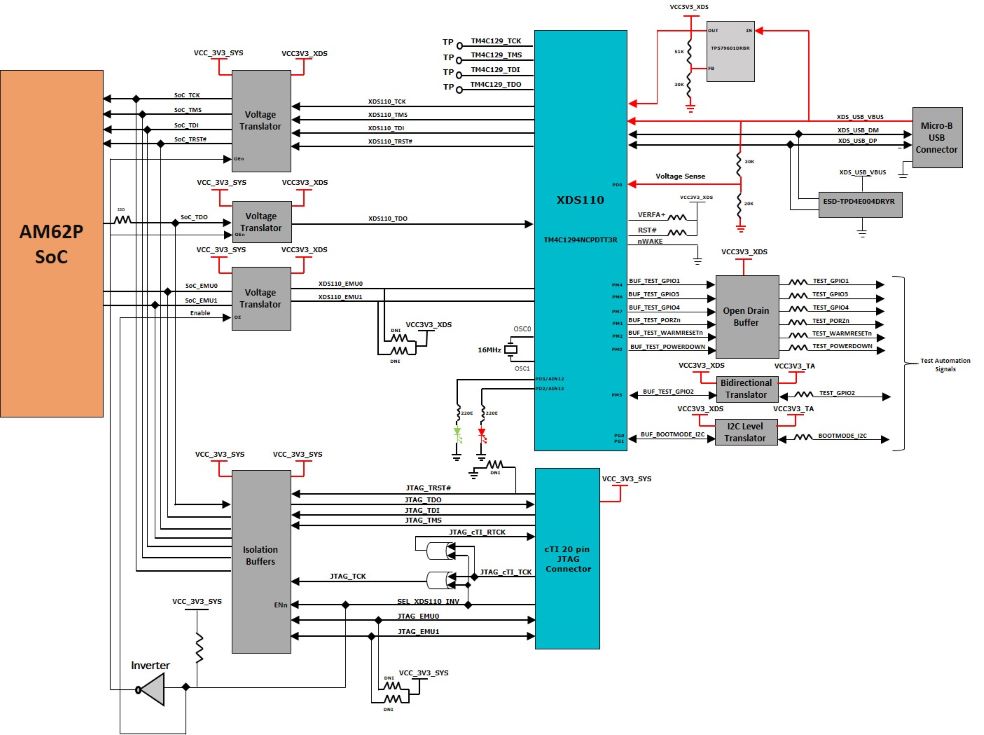SPRUJA2 November 2023
- 1
- Description
- Get Started
- Features
- 5
- 1Evaluation Module Overview
-
2Hardware
- 2.1 Additional Images
- 2.2 Key Features
- 2.3 Interface Mapping
- 2.4 Power ON/OFF Procedure
- 2.5 Clocking
- 2.6 Reset
- 2.7 CSI Interface
- 2.8 OLDI Interface
- 2.9 DSI Interface
- 2.10 Audio Codec Interface
- 2.11 HDMI Display Interface
- 2.12 JTAG Interface
- 2.13 Test Automation Header
- 2.14 UART Interface
- 2.15 USB Interface
- 2.16 Memory Interfaces
- 2.17 Ethernet Interface
- 2.18 GPIO Port Expander
- 2.19 GPIO Mapping
- 2.20 Power
- 2.21 EVM User Setup/Configuration
- 2.22 Expansion Headers
- 2.23 Interrupt
- 2.24 I2C Address Mapping
- 3Hardware Design Files
- 4Compliance Information
- 5Additional Information
2.12 JTAG Interface
AM62P SK EVM includes XDS110 class on board emulation. The connection for this emulator uses a standard USB 2.0 micro-B connector and the circuit acts as a Bus powered USB device. The VBUS power from the connector is used to power the emulation circuit such that connection to the emulator is not lost when the power to the SKEVM is removed. Voltage translation buffers are used to isolate the XDS110 circuit from the rest of the SK EVM.
Optionally, JTAG Interface on SK EVM is also provided through a 20 Pin Standard JTAG cTI Header J23. This allows the user to connect an external JTAG Emulator Cable. Voltage translation buffers are used to isolate the JTAGsignals of cTI header from rest of the SK EVM. The output of the voltage translators from XDS110 Section and cTI Header Section are muxed and connected to the AM62P JTAG Interface. If a connection to the cTI 20 Pin JTAG connector is sensed using an auto presence detect circuit, the mux routes the 20 pin signals from the cTI connector to the AM62P SoC in place of the on-board emulation circuit.
 Figure 2-12 JTAG Interface
Figure 2-12 JTAG InterfaceThe pin-outs of the cTI 20 pin JTAG connector are given in the table below. A ESD protection part number TPD4E004 is provided on USB signals to steer ESD current pulses to VCC or GND. TPD4E004 protects against ESD pulses up to ±15-kV Human-Body Model (HBM) as specified in IEC 61000-4-2 and provides ±8-kV contact discharge and ±12- kV air-gap discharge.
| Pin No. | Signal |
|---|---|
| 1 | JTAG_TMS |
| 2 | JTAG_TRST# |
| 3 | JTAG_TDI |
| 4 | JTAG_TDIS |
| 5 | VCC_3V3_SYS |
| 6 | NC |
| 7 | JTAG_TDO |
| 8 | SEL_XDS110_INV |
| 9 | JTAG_cTI_RTCK |
| 10 | DGND |
| 11 | JTAG_cTI_TCK |
| 12 | DGND |
| 13 | JTAG_EMU0 |
| 14 | JTAG_EMU1 |
| 15 | JTAG_EMU_RSTn |
| 16 | DGND |
| 17 | NC |
| 18 | NC |
| 19 | NC |
| 20 | DGND |